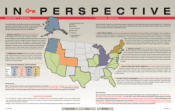KeyBank 2006 Annual Report Download - page 19
Download and view the complete annual report
Please find page 19 of the 2006 KeyBank annual report below. You can navigate through the pages in the report by either clicking on the pages listed below, or by using the keyword search tool below to find specific information within the annual report.
19
MANAGEMENT’S DISCUSSION & ANALYSIS OF FINANCIAL CONDITION & RESULTS OF OPERATIONS KEYCORP AND SUBSIDIARIES
Forward-looking statements
This report may contain “forward-looking statements” within the
meaning of the Private Securities Litigation Reform Act of 1995,
including statements about Key’s long-term goals, financial condition,
results of operations, earnings, levels of net loan charge-offs and
nonperforming assets, interest rate exposure and profitability. These
statements usually can be identified by the use of forward-looking
language such as “our goal,” “our objective,” “our plan,” “will likely
result,” “expects,” “plans,” “anticipates,” “intends,” “projects,”
“believes,” “estimates,” or other similar words or expressions or
conditional verbs such as “will,” “would,” “could” and “should.”
Forward-looking statements express management’s current expectations,
forecasts of future events or long-term goals and, by their nature, are
subject to assumptions, risks and uncertainties. Although management
believes that the expectations, forecasts and goals reflected in these
forward-looking statements are reasonable, actual results could differ
materially from the forward-looking statements for a variety of reasons,
including the following factors.
Interest rates. Net interest income can be affected by changes in market
interest rates (higher or lower) and the composition of Key’s interest-
earning assets and interest-bearing liabilities.
Trade, monetary or fiscal policy. The trade, monetary and fiscal policies
implemented by government and regulatory bodies, such as the Board
of Governors of the Federal Reserve System may affect the economic
environment in which Key operates and, therefore, impact Key’s financial
condition and results of operations.
Economic conditions. Changes in general economic conditions, or in
the condition of the local economies or industries in which Key has
significant operations or assets, could, among other things, materially
impact credit quality trends and our ability to generate loans.
Credit risk. Increases in interest rates and/or weakening economic
conditions could diminish the ability of borrowers to repay outstanding
loans or the value of the collateral securing those loans. Additionally,the
allowance for loan losses may be insufficient if the estimates and judgments
management used to establish that allowance prove to be inaccurate.
Market dynamics and competition. Key’s revenue is susceptible to
changes in the markets Key serves, including changes resulting from
mergers, acquisitions and consolidations among major clients and
competitors. The prices charged for Key’s products and services and,
hence, their profitability, could change depending on market demand,
actions taken by competitors, and the introduction of new products
and services.
Strategic initiatives. Results of operations could be affected by the
success or lack of success of management’s initiatives to grow revenues
and manage expenses or by changes in the composition of Key’s business
(including changes from acquisitions and divestitures) and in the
geographic locations in which Key operates.
Technological change. Key’s financial performance depends in part on
our ability to utilize technology efficiently and effectively to develop,
market and deliver new and innovative products and services.
Operational risk. Key may experience operational or risk management
failures due to technological or other factors.
Regulatory compliance. KeyCorp and its subsidiaries are subject to
voluminous and complex rules, regulations and guidelines imposed by a
number of government authorities. Monitoring compliance with these
requirements is a significant task, and failure to comply may result in
penalties that could have an adverse effect on Key’s results of operations.
In addition, regulatory practices, requirements or expectations may
continue to expand.
Legal obligations. Key may become subject to new legal obligations, or
the resolution of pending litigation may have an adverse effect on
financial results.
Regulatory capital. KeyCorp and KBNA must meet specific capital
requirements imposed by federal banking regulators. Sanctions for
failure to meet applicable capital requirements may include regulatory
enforcement actions that restrict dividend payments, require the adoption
of remedial measures to increase capital, terminate Federal Deposit
Insurance Corporation (“FDIC”) deposit insurance, and mandate the
appointment of a conservator or receiver in severe cases.
Capital markets conditions. Changes in the stock markets, public
debt markets and other capital markets could affect Key’s stock price,
Key’s ability to raise necessary capital or other funding, or Key’s ability
to securitize and sell loans. In addition, Key’scapital markets activities,
such as underwriting and brokerage activities, investment and wealth
management advisory businesses, and private equity investment activities,
could be adversely affected by changes in the capital markets. Key’saccess
to the capital markets and liquidity could be adversely affected by direct
circumstances, such as a credit downgrade, or indirect circumstances with
market-wide consequences, such as terrorism or war,natural disasters,
political events, or the default or bankruptcy of a major corporation,
mutual fund or hedge fund. Similarly, market speculation about Key
or the banking industryin general may adversely affect the cost and
availability of normal funding sources.
Business continuity.Although Key has disaster recoveryplans in place,
events such as natural disasters, terrorist activities or military actions
could damage facilities or otherwise disrupt operations. Such events could
have an adverse effect on Key’s results of operations.
International operations. Key meets the equipment leasing needs of
companies worldwide. Economic and political uncertainties resulting
from terrorist attacks, military actions or other events that affect the
countries in which Key operates may have an adverse effect on results
of operations.
Accounting principles and taxation. Changes in U.S. generally accepted
accounting principles (“GAAP”) could have a significant adverse effect
on Key’s reported financial results. Although these changes may not have
an economic impact on Key’s business, they could affect our ability to
attain targeted levels for certain performance measures. In addition,
changes in domestic tax laws, rules and regulations, including the
interpretation thereof by the Internal Revenue Service or other
governmental bodies, could adversely affect Key’s financial condition or
results of operations.
Previous Page
Search
Next Page
Contents
























